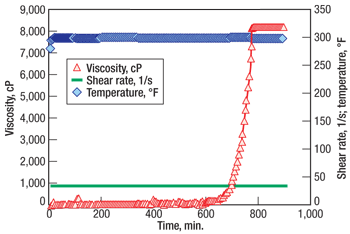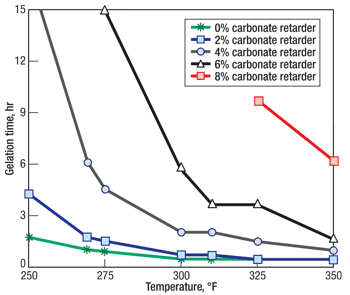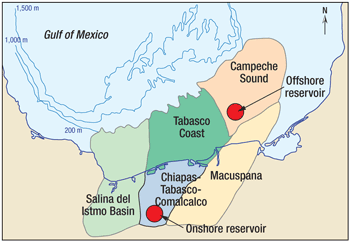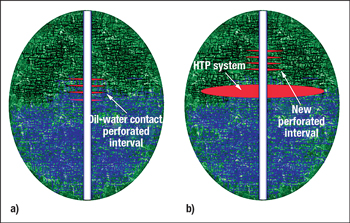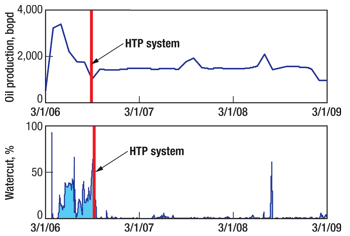New polymer chemistry extends temperature range of water control
In highly fractured reservoirs onshore and offshore Mexico, the ability to effectively stop water coning at temperatures exceeding 250°C greatly extended the life of producing wells.
Modesto Mercado, Juan Acuna and Ramon Hernandez, Pemex; Julio Vasquez, Eduardo Soriano and Carlos Caballero, HalliburtonExcessive water production is one of the most serious problems in the oil industry, with major effects on the economic life of producing wells. Remediation techniques for controlling water production, generally referred to as conformance control, include the use of polymer systems to reduce or plug permeability in the water-producing intervals. The principle is to pump the polymer system into the formation around the wellbore and allow it to propagate through the rock matrix. In situ gelation takes place, plugging pore spaces and channels and, thus, limiting undesired water flow. Application of polymer systems for conformance control is often limited by these systems’ limited gelation time and thermal stability at high temperatures. This limitation has led to the development of polymer systems specifically for conformance control in high-temperature reservoirs. This article presents a successful field implementation of one such high-temperature polymer (HTP) for water and gas shutoff applications in highly naturally fractured carbonate reservoirs with bottomhole temperatures (BHTs) greater than 250°F. The HTP system was successfully applied to reduce water production in 18 jobs in naturally fractured carbonate reservoirs onshore and offshore Mexico. The polymer system originally had a working temperature range limited to 100–250°F, above which pumping times were too short. But addition of a recently developed carbonate retarder allows reasonable placement times up to 350°F, without the need for cooling down the formation to obtain enough pumping time. To date, more than 100 jobs have been successfully performed worldwide using the HTP with the new retarder at temperatures higher than 250°F. Because the HTP system can also withstand differential pressures up to 2,500 psi, workover operations have been successfully performed in previously treated wells, including acid stimulation, sand control and frac-pack treatments. HIGH-TEMPERATURE POLYMER One of the most widely used polymer systems for conformance control employs polyacrylamides (PAMs) or acrylamide copolymer with chromium(III) as a crosslinker. Chromium(III) has been extensively used because of its high success rate and relatively low cost. However, the short gelation times of this system at elevated temperatures limit its application to low- to moderate-temperature reservoirs.1 Another polymer system widely used is a water-based gel based on phenol/formaldehyde crosslinker for homo-, co- and ter-polymer systems containing acrylamide. The loss of phenol by partitioning when it comes into contact with crude oil has been identified as an important issue for that polymer system.2 The toxicity issues associated with formaldehyde and phenol have been addressed by other researchers.3 Systems based on polyethyleneimine (PEI) as a crosslinker and a base copolymer of acrylamide and t-butyl acrylate (PAtBA) have been reported to propagate deep into the matrix to provide excellent thermal stability. Although this polymer system has been successfully implemented in field operations, some features need improvement for high-temperature reservoirs. In particular, gel times are too short at temperatures higher than 250°F.4,5 The challenge for high-temperature applications is mainly the capability to provide longer gelation times and acceptable thermal stability. The high-temperature polymer system uses PAtBA as a base polymer, and a low-toxicity material based on PEI as the organic crosslinker. The amine groups on PEI react with the amide (and probably with the ester groups) to form an amide linkage. Because of the presence of multiple amine groups on the PEI and ester/amide groups on the PAtBA, this results in a crosslinked, three-dimensional gel structure. The short gel times are thought to be caused by an increased reaction rate of the PEI amine groups with the polymer ester/amide groups. To make this polymer system work at higher temperatures in the past, a preflush phase would be required to cool down the zone to about 250°F so that the polymer system could be placed before gelling. However, a recently developed carbonate retarder has been added to the system to delay its crosslinking time. Gelation time is one of the most important characteristics of a polymer system because it defines the pumping time available to safely place the system into the matrix of the rock. Gelation time corresponds to the inflection point of the viscosity-versus-time curve, Fig. 1. Gelation time needed for a particular application will be dictated by reservoir and wellbore conditions, such as reservoir depth, length of the interval to be treated, BHT, injection rate and shut-in time program.
Without the addition of the carbonate retarder, gelation times for the HTP system were short (less than 2 hr) at temperatures higher than 250°F, Fig. 2. For high temperatures, the use of high PAtBA concentrations (i.e., 7% active) is recommended to obtain a more thermally stable gel.
Sandpack flow tests were conducted to evaluate the HTP system’s effectiveness for limiting permeability to water at 350°F. Sand formulation consisted of a mixture of 70–325-mesh (US) sand and bentonite. The following sequence was used in the flow test: water, oil, water, HTP treatment, water. The effective permeability to water was found to decrease from 1,069 mD before treatment to zero (i.e., no water flow) after HTP injection into the sandpack, and the HTP remained thermally stable with zero flow after 30 days of exposure to 350°F. CARBONATE RESERVOIRS Offshore and onshore hydrocarbon production wells in Mexico experience major challenges with water management. Water production results in extra disposal costs, scale buildup, reduced oil output and, eventually, well abandonment (with associated workover costs). Consequently, producing zones are often abandoned early to avoid excessive water production, even when intervals still retain large volumes of recoverable hydrocarbons. Although natural fractures have a positive effect on oil flow, they also negatively impact water and/or gas flow caused by coning effects or high-permeability streaks between the producing hydrocarbon zone and intervals above and/or below. If these zones contain high mobile-water saturation, they soon will impact the productivity of the hydrocarbon zone. Early water breakthrough caused by edge-water flowing through faults or natural fractures is another common problem in this region. In addition, many of these formations with high-water-management problems produce from intervals with BHTs higher than 250°F, limiting the applicability of most polymer sealants. The case histories discussed in this article pertain to inland and offshore reservoirs in Mexico. To address these issues, the HTP system with the new retarder was applied in several locations in an onshore and an offshore reservoir in Mexico, Fig. 3.
The onshore field is an asymmetric, anticlinal geologic structure with NW–SE direction affected by normal and inverse faulting with the presence of saline intrusions to the north and the south of the structure. The gross thicknesses of the rocks that lodge the deposit vary 1,371–5,233 ft, whereas the net thicknesses vary 1,089–4,400 ft. The producing area covers 28.26 sq mi, including the Lower Cretaceous formation and the Upper Jurassic Kimmeridgian. These are naturally fractured deposits formed by limestone and dolomites with permeability that varies 10–120 mD. Matrix porosities vary 2–8%. The reservoir is located at depths of 15,090–21,000 ft and holds a volatile oil deposit of 38°API, with an initial pressure of 10,056 psi and a bubble pressure of 3,726 psi. Currently, the reservoir is under depleted conditions with an actual reservoir pressure of 3,130 psi and an average BHT of 307°F. The recovery mechanism is water drive, and the original oil-water contact was located at 21,077 ft. The current oil-water contact varies along the field and is influenced by the extensive net of natural fractures and faults. Producing zones lie within carbonate reservoirs, drilled at depths that, in some cases, reach 19,700 ft TVD. The producing formations generally vary 200–350 ft in thickness but exceed this range in some cases. The main mechanisms of production in this area are natural fractures located along the entire producing interval. These reservoirs are basically depleted and classified as mature. Most of the wells require gas lifting to sustain oil production. The offshore field is located on the continental shelf of the Gulf of Mexico, off the coast of Tabasco and Campeche, about 82 mi from the Dos Bocas Marine Terminal in Paraíso, Tabasco, and about 50 mi northeast from Ciudad del Carmen, Campeche. This project includes four fields, which are offshore complex facilities and are strategic for managing the production in the southwestern marine region. The main reservoir rocks are dolomitic carbonated breccias from the Upper Cretaceous–Lower Paleocene. They consist of 164–492 ft of coarse-grained carbonated breccias, strongly dolomitized and naturally fractured, with secondary vuggy porosity caused by diagenetic dissolution. Porosity is between 6 and 14%, and permeabilities range 100–3,000 mD. Hydrocarbon production from these reservoirs has an oil gravity of about 30°API. CASE HISTORIES IN MEXICO A few case histories are described below related to the rising of the oil-water contact in these two fields, which becomes a major challenge in terms of excessive water production. The HTP system is used to form a horizontal barrier to stop or delay the oil-water contact from reaching the newly perforated interval, Fig. 4.
Well 1 (onshore) is a vertical, cased-hole well drilled to 18,100 ft and completed in an openhole section of 1,070 ft of carbonate formation. The BHT was 300°F. Well 1 was initially acid stimulated to improve oil production; however, a watercut of almost 90% was observed after acid treatment. The operator then decided to try to decrease water production by pumping the HTP system followed by a small tail-in of foamed cement. This operation was carried out with coiled tubing (CT) in three stages, alternating the HTP system and the foamed cement. The three HTP/foamed-cement stages focused on sealing off a net of natural fractures present at the bottom of the openhole section. After the third stage was complete, the well was shut in overnight to allow the system to fully crosslink. Following the treatment, the remaining exposed openhole section was acid stimulated and the well was put back on production. Figure 5 illustrates the results of the treatment, which decreased the watercut from 90% to 0.2%, even two years later.
Well 2 (onshore) is a vertical, cased-hole well perforated at 18,600 ft, with a BHT of 300°F. The well produced oil for almost 10 years at low water rates, after which watercut slowly started increasing until it reached 97%. The interval was isolated with a mechanical plug, and then a new interval was perforated at 17,400 ft. This new interval again began producing water, so the operator considered an HTP treatment to shut off the water. The HTP system, along with a small tail-in of foamed cement, was bullheaded into the formation to seal off the interval. The well was shut in overnight to allow the HTP system to fully crosslink. The interval was re-perforated, but this time only the top 124 ft of the original 196 ft of perforations was opened. This was followed by an acid stimulation job. This treatment resulted in nearly water-free oil production, with only a 5% watercut after two years. Well 3 (onshore) is also a vertical, cased-hole well perforated at the interval 18,319–18,351 ft. The BHT was 306°F. This interval eventually reached watercut values up to 45%. Similar to the previous two cases, the HTP system was pumped followed by a small tail-in of foamed cement. The treatment was bullheaded and then shut in overnight. The operator decided to perforate a few feet up from the isolated interval at 18,143 ft, in the same carbonate formation. This was followed by an acid stimulation treatment. Two additional acid treatments were conducted during the next two years, during which time watercut has averaged about 4%. Well 4 (onshore) is a deviated well drilled to 19,680 ft MD. The well was completed with an openhole interval of 818 ft. The formation BHT was 305°F. This openhole section was acid-stimulated, inducing an average watercut of 60%. To decrease water production, the HTP system was pumped with the aid of CT, followed by a small tail-in of foamed cement. After the treatment, the watercut dropped to 2–10% and remained stable for five months, after which the operator decided to acid stimulate this interval again to improve oil production. This induced a watercut increase to 30%. A second HTP treatment was performed with the aid of CT, yielding an immediate watercut reduction to 2%. This level has remained stable for two years, despite two additional acid treatments that have caused brief spikes in watercut up to 30%. Well 5 (offshore) is a deviated, cased-hole, offshore well drilled to 12,546 ft TVD and completed in a carbonate formation from 14,173 to 14,222 ft MD, for a 49-ft interval. The BHT was 290°F. This well started producing in September 1992 with no water production until 2005, when the oil-water contact reached the perforations. In April 2008, Well 5 produced 4,418 bpd of total fluid, comprising 1,902 bopd and 2,516 bwpd (i.e., 57% watercut). The treatment consisted of bullheading 189 bbl of seawater spacer and 622 bbl of the HTP system (having a theoretical radial penetration of 16 ft) displaced with seawater. The well was then shut in overnight, and then re-perforated a few feet up, in a 65-ft interval at 13,993–14,058 ft MD. Initial production was 2,927 bopd with no water. After one year of production, the well still showed less than 4% watercut. Well 6 (offshore) is a deviated, cased-hole well drilled to 14,114 ft TVD and completed in a carbonate formation from 12,234 to 12,277 ft MD, for a 43-ft interval. The BHT was 285°F. The well began producing in September 1993 with no water production until the end of 2005, when the oil-water contact reached the perforations. In June 2007, the well produced 4,120 bpd of total fluid, comprising 1,026 bopd and 3,094 bwpd (i.e., 60% watercut). The treatment consisted of bullheading 377 bbl of seawater spacer and 201 bbl of the HTP system (having a theoretical radial penetration of 10 ft) displaced with seawater. The well was then shut in overnight. This well was re-perforated a few feet up, in a 43-ft interval at 12,044–12,087 ft MD. Initial production was 2,060 bopd with 0.55% watercut, which remained less than 5% after one year of production. Well 7 (offshore) is a deviated, cased-hole, offshore well drilled to 14,114 ft MD and completed in a carbonate formation from 13,468 to 13,517 ft MD, for a 49-ft interval. The BHT was 285°F. Production commenced in September 1993 with no water production until July 2006, when the oil-water contact reached the perforations. In December 2007, the well produced 5,429 bpd of total fluid, comprising 2,325 bopd and 3,104 bwpd (i.e., 57% watercut). The treatment consisted of bullheading 377 bbl of seawater spacer and 252 bbl of the HTP system (having a theoretical radial penetration of 12 ft) displaced with seawater. The well was then shut in overnight, and was then re-perforated a few feet up, in a 66-ft interval at 13,106–13,172 ft MD. Initial production was 5,014 bopd with no water, and after one year of production, the well still showed less than 1% watercut. Table 1 summarizes the watercut behavior of Wells 1–4 and 11 other wells treated in the onshore reservoir under study in Mexico, tracking the watercut up to one year after the HTP treatment was performed.
CONCLUSIONS The development of the new carbonate retarder extends the temperature range of application of the HTP system up to 350°F. Reasonable gelation times can be achieved up to 350°F, without the need to cool down the formation to obtain sufficient pumping time. The retarder is not detrimental to the thermal stability of the system. Based on the laboratory evaluation, the HTP system provides excellent permeability reduction and good thermal stability at 350°F. It has also been found to be resistant to acid, CO2 and H2S. The HTP system is able to address conformance problems in sandstone and carbonate formations, including water coning/cresting, high-permeability streaks, gravel-pack isolation, fracture shutoff and casing-leak repair. To date, more than 100 field implementations have been performed with the recently developed retarder at temperatures higher than 250°F. ACKNOWLEDGMENTS This article was prepared from SPE 135101 presented at the SPE Annual Technical Conference and Exhibition held in Florence, Italy, Sept. 19–22, 2010. The authors thank Pemex and Halliburton for support and permission to publish this information. LITERATURE CITED 1 Bartosek, M., Mennella, A. and T. Lockhart, “Polymer gels for conformance treatments: Propagation of Cr(III) crosslinking in porous media,” SPE/DOE 27828 presented at the SPE/DEO Ninth Symposium on Improved Oil Recovery, Tulsa, Okla., April 17–20, 1994.
|
||||||||||||||||||||||||||||||||||
- What's new in production (February 2024)
- Prices and governmental policies combine to stymie Canadian upstream growth (February 2024)
- U.S. operators reduce activity as crude prices plunge (February 2024)
- U.S. producing gas wells increase despite low prices (February 2024)
- U.S. drilling: More of the same expected (February 2024)
- U.S. oil and natural gas production hits record highs (February 2024)

